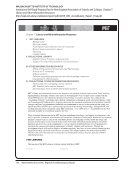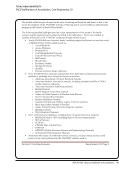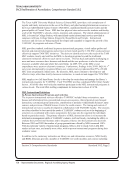100 · Representative Documents: Regional Accrediting Agency Reports
Brigham Young University
Northwest Commission on Colleges and Universities (NWCCU). Library and Information Resources 5
courses using the university’s online course-management system integrated electronic reserve
materials with the system to provide students with a single point of access for course-related
content. By fall 2005 all courses offered through the university course-management system
linked directly to the library’s electronic reserve system.
Reference and Information Services
Reference service is provided at nine subject-related desks in the Lee Library and
one desk in the Hunter Library. Typically each desk is staffed by student assistants and staff
employees with professional subject librarians providing backup. Professional librarians, many
with an advanced degree in their subject specialty, also provide one-on-one research assistance
by appointment and through e-mail. The total number of reference queries fielded at library
reference desks places BYU high in ARL rankings (16th), reflecting the success of staffing
multiple service points near related research tools and collections (table 5.2).
In February 2005 the Lee Library participated in the Wisconsin-Ohio Reference
Evaluation Program (WOREP) study to measure the effectiveness of reference service provided
at reference desks. Findings showed that reference personnel at the Lee Library satisfied 72.5
percent of patrons’ requests in helping them find exactly what they wanted. BYU was the top
scoring library among the 116 institutions that participated in WOREP (RE 5.14).
Since 2001, BYU has participated three times in LibQUAL+™, a nationwide ARL-
sponsored assessment of library users’ perceptions of the quality of library service. This program
asks students and faculty to express their personal expectations (both minimum and desired) for
library collections and services and then to rate their own library’s performance relative to those
expectations on a Likert scale from 1 to 9, with 1 being low and 9 high. Results from the 2004
survey, as reflected in figure 5.1, indicate how patrons perceive the service they receive in the
library (“Affect of Service”). The 2004 LibQUAL+ results showed that the Lee Library exceeded
student and faculty minimum expectations in this category (RE 5.5). The Hunter Law Library
achieved even better results, with student and faculty perceptions of Affect of Service
approaching desired expectations. Although reference service is perceived to be strong, the
library has set the goal of improving outreach efforts with students and faculty. Figure 5.1 also
shows the overall results of the survey for the other ARL institutions that participated.
Librarians provide reference service via e-mail, accounting for about 3 percent of total
reference activity. Between January 2002 and June 2005 the Lee Library provided an online
“chat” reference service which gave students and faculty the opportunity to interact with
a librarian in real time from any computer with Web access. Although this service was received
positively, it failed to grow to supportable levels and was therefore discontinued.
Information Literacy
BYU’s libraries operate one of the country’s outstanding information literacy programs,
teaching over 30,000 individuals each year. The libraries rank fourth among ARL libraries in
numbers of students reached through information literacy sessions conducted by librarians (table
5.2). With a library unit embedded in both the freshman and advanced levels of University
Core English composition courses, students learn fundamental as well as subject-specific
research tools and strategies. Subject librarians also work directly with faculty to develop
instruction sessions for courses with research- or library-based assignments. During 2004,
Brigham Young University
Northwest Commission on Colleges and Universities (NWCCU). Library and Information Resources 5
courses using the university’s online course-management system integrated electronic reserve
materials with the system to provide students with a single point of access for course-related
content. By fall 2005 all courses offered through the university course-management system
linked directly to the library’s electronic reserve system.
Reference and Information Services
Reference service is provided at nine subject-related desks in the Lee Library and
one desk in the Hunter Library. Typically each desk is staffed by student assistants and staff
employees with professional subject librarians providing backup. Professional librarians, many
with an advanced degree in their subject specialty, also provide one-on-one research assistance
by appointment and through e-mail. The total number of reference queries fielded at library
reference desks places BYU high in ARL rankings (16th), reflecting the success of staffing
multiple service points near related research tools and collections (table 5.2).
In February 2005 the Lee Library participated in the Wisconsin-Ohio Reference
Evaluation Program (WOREP) study to measure the effectiveness of reference service provided
at reference desks. Findings showed that reference personnel at the Lee Library satisfied 72.5
percent of patrons’ requests in helping them find exactly what they wanted. BYU was the top
scoring library among the 116 institutions that participated in WOREP (RE 5.14).
Since 2001, BYU has participated three times in LibQUAL+™, a nationwide ARL-
sponsored assessment of library users’ perceptions of the quality of library service. This program
asks students and faculty to express their personal expectations (both minimum and desired) for
library collections and services and then to rate their own library’s performance relative to those
expectations on a Likert scale from 1 to 9, with 1 being low and 9 high. Results from the 2004
survey, as reflected in figure 5.1, indicate how patrons perceive the service they receive in the
library (“Affect of Service”). The 2004 LibQUAL+ results showed that the Lee Library exceeded
student and faculty minimum expectations in this category (RE 5.5). The Hunter Law Library
achieved even better results, with student and faculty perceptions of Affect of Service
approaching desired expectations. Although reference service is perceived to be strong, the
library has set the goal of improving outreach efforts with students and faculty. Figure 5.1 also
shows the overall results of the survey for the other ARL institutions that participated.
Librarians provide reference service via e-mail, accounting for about 3 percent of total
reference activity. Between January 2002 and June 2005 the Lee Library provided an online
“chat” reference service which gave students and faculty the opportunity to interact with
a librarian in real time from any computer with Web access. Although this service was received
positively, it failed to grow to supportable levels and was therefore discontinued.
Information Literacy
BYU’s libraries operate one of the country’s outstanding information literacy programs,
teaching over 30,000 individuals each year. The libraries rank fourth among ARL libraries in
numbers of students reached through information literacy sessions conducted by librarians (table
5.2). With a library unit embedded in both the freshman and advanced levels of University
Core English composition courses, students learn fundamental as well as subject-specific
research tools and strategies. Subject librarians also work directly with faculty to develop
instruction sessions for courses with research- or library-based assignments. During 2004,
























































































































































































